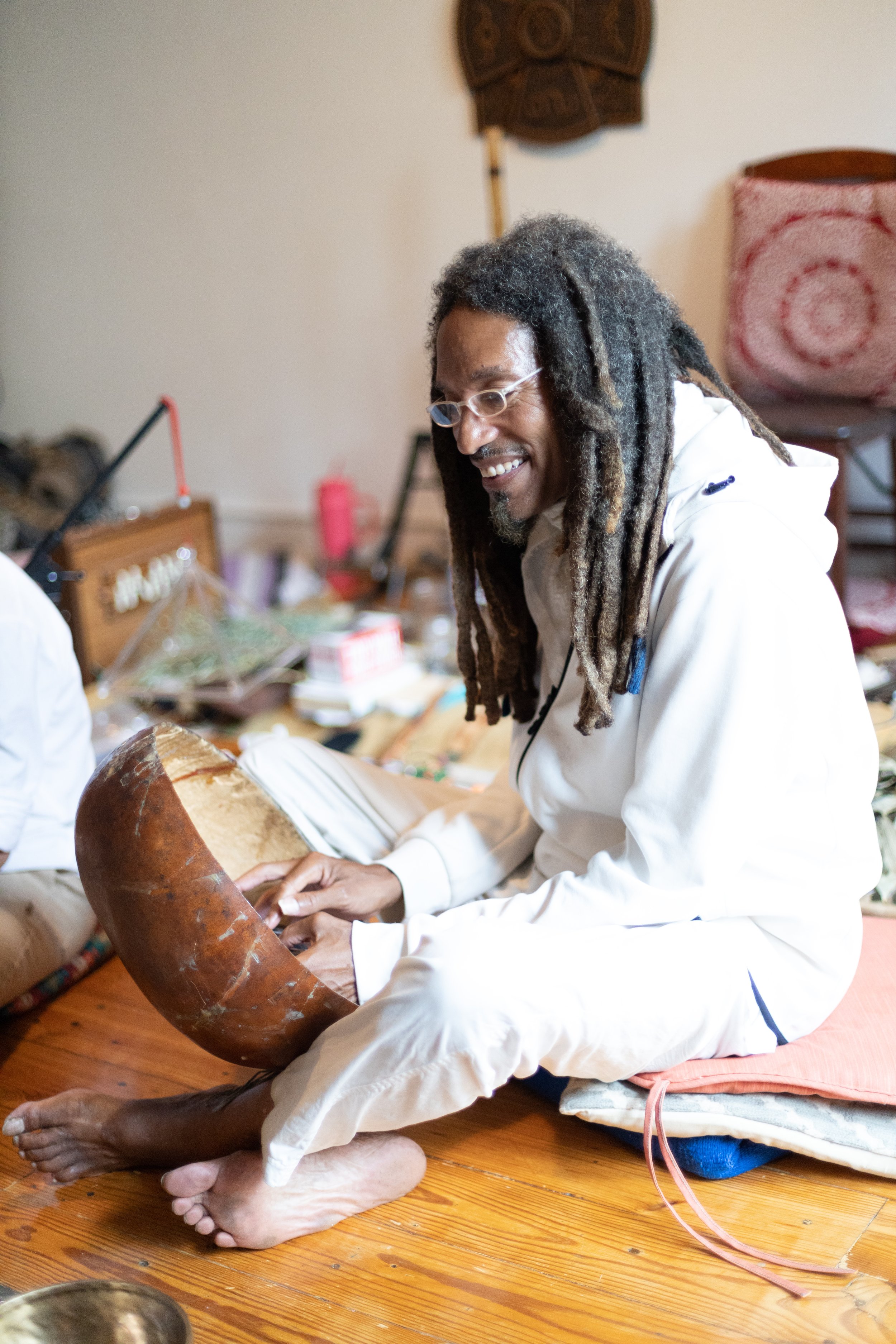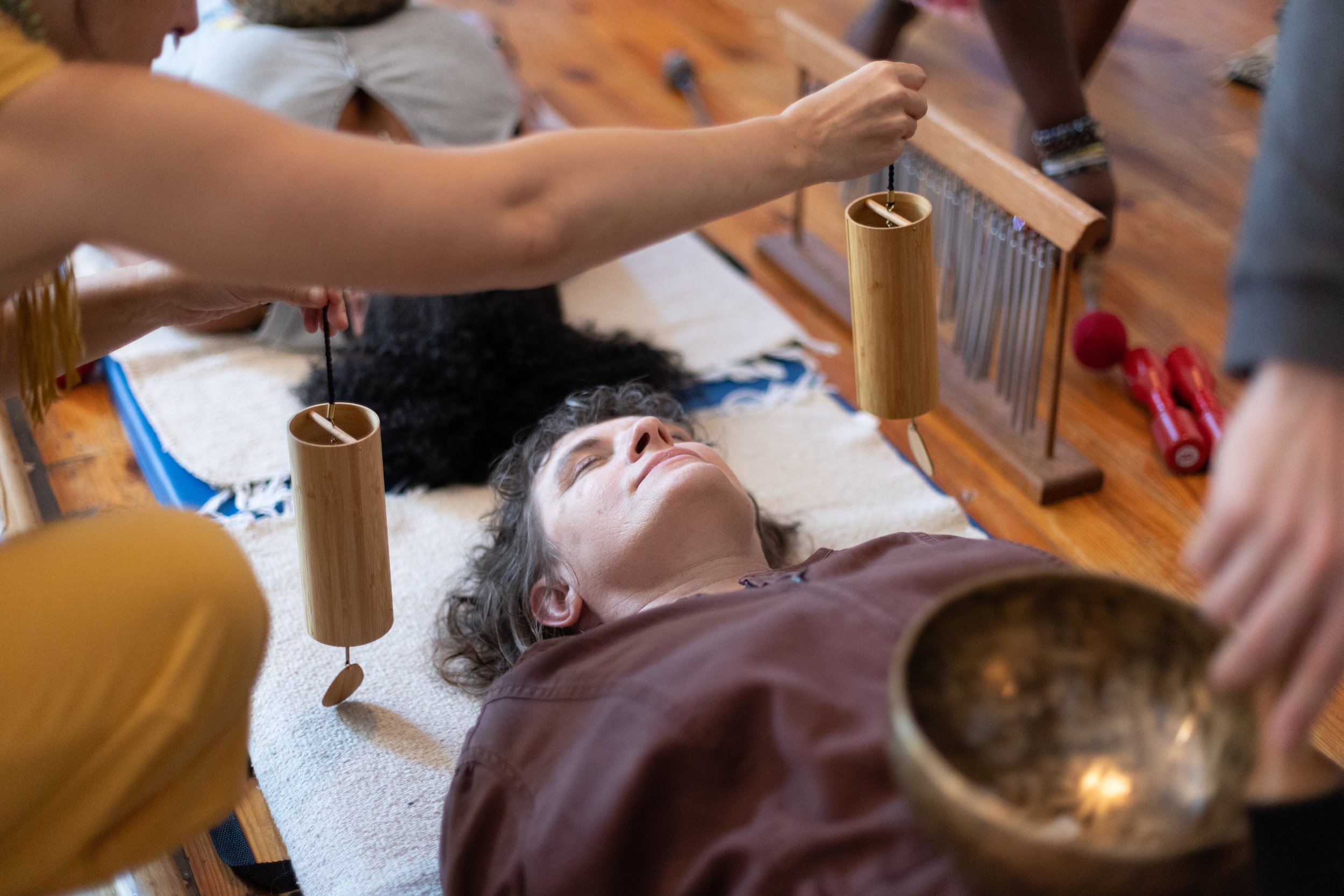
Integrating the Science and Spirituality of Sound and Music for Healing and Meditation
The Sonic Institute offers experiential workshops, training programs, healing sessions and events designed to help people connect with sound and music as a tool for healing and meditation.
90 Day Sound Facilitator Training
Are you looking to incorporate sound healing and meditation techniques in your wellness practice?
We help wellness practitioners of all kinds—yoga teachers, massage therapists, acupuncturists, etc.—integrate skills and knowledge necessary to facilitate sound healing and meditation experiences with confidence and integrity. Our 12 week, 60+ hour online and 1:1 program explores the science, physics, metaphysics and spirituality of sound with diverse global perspectives and individualized attention. Sign up for a call if you’re serious about learning more.
Our sound healer training programs provide participants with skills and knowledge needed to facilitate guided meditation and sound healing experiences.
Sound Healer Training
Music Lessons
Learn everything from voice to guitar, traditional flute, music theory, rhythm, sound healing and more with our caring and qualified teachers.
Online Courses
Learn from anywhere in the world. Our online lessons and courses empower you to self-educate through interactive, multimedia content.
Healing Sessions
Schedule a private sound healing session to assess and enhance your well-being.
“By the end of the experience, my thoughts had calmed and my nervous system felt regulated for the first time in years. I felt safe and calm.” — Alyssa
Workshops & Events
Experiential workshops, concerts, sound baths and other events designed to connect people directly with the power of sound and music as tools for healing and meditation.
Elements of Sound: A Full-Spectrum Exploration of Sound and Consciousness
By Adrian DiMatteo
“This is not just a book, it’s an experience. Well-written, thought provoking, educational, enlightening, fascinating—the list goes on. ‘Full-spectrum’ is a perfect way to describe it. Elements of Sound is a book within a book, a masterpiece of literary art on the subjects of sound and consciousness. This is certainly a book to be read again and again.”
— Kathy Lord, Co-Founder/Managing Director, Music That Heals

Sound as Medicine Online Course Available Now!
Do you want to learn to facilitate sound healing and meditation experiences with confidence and integrity? Our online training program features 10 episodes of high-definition content exploring sound, altar construction, hygiene for practitioners, healing techniques, training with the voice and a wide range of instruments.
Why does music help?
The intentional use of sound can greatly aid people on the journey to inner peace, which is essential to healing and understanding.
-
Music cognition involves more parts of the brain than virtually any other activity, affecting:
Memory (hippocampus)
Motor skills and spatial awareness (cerebrum, cerebellum, motor cortex, sensory cortex, and visual cortex)
Linguistic and auditory processing (auditory cortex, cerebellum, prefrontal cortex)
Emotional processing (limbic system, nucleus accumbens, amygdala, and the cerebellum)
Playing music requires creativity, imagination, focus and coordination. Learning an instrument and practicing music enhances these capacities. Psychologically, music provides a means of nonverbal communication, providing an outlet for connecting with and expressing emotion. As a safe and healthy activity, it can help deemphasize obsessive thinking and compulsive behavior. As a non-invasive treatment, sound and music therapies promote relaxation and reduce pain while reducing or eliminating the need for pharmaceutical medications and their associated side effects.
-
Music + The Body
Sound waves tangibly impact the physical body in many ways, depending on whether they are passively received or actively produced:
Stimulation of the vagus nerve (affects digestion, heart rate and immune function)
Promoting coherence between the electromagnetic fields of the heart and brain
Regulation of the circulatory system
Regulation of the endocrine system
Regulation of the sympathetic, parasympathetic and autonomic nervous systems
Infrasound and ultrasound have numerous medical applications
Cellular and molecular “massage” when sound waves penetrate the physical body
-
Simply put, music is a deeply human activity (although not limited to the human species). Musical practices and traditions are distinguishing aspects of culture and are deeply interwoven with cosmology and community life. In that regard, shared music-making and dance can promote meaningful relationships and connections within and across social groups, leading to an improved quality of life, shared values and sense of belonging.
Due to the interwoven mental, physical and emotional aspects of music cognition, music-making lies at the intersections of art, psychology, philosophy and science. Because of this, music therapies are well positioned to promote balance on all levels and provide access to cathartic and transcendental experiences.
“Music may be the activity that prepared our pre-human ancestors for speech communication and for the very cognitive, representational flexibility necessary to become humans.”
— Daniel J. Levetin, This Is Your Brain on Music: The Science of a Human Obsession
What is healing?
Medical traditions throughout the world address healing in many ways, offering an astounding array of methods and protocols for facilitating healing experiences through sound. In our view, healing means balance. Broadly speaking, people suffer from a range of mental, emotional and physical imbalances which can lead to sickness.
Thoughts, emotions and physical sensations are interconnected. Illness manifests according to the severity and persistence of mental, emotional and physical distress. To promote balance, healing technologies address these issues through complementary practices. Examples include strengthening the rational mind to better manage emotional volatility, or engaging with somatic experience to decentralize an over-active intellect and address emotional disconnect.
“Sound as a luminous vibration can regenerate your cells, organize them, make them vibrate in harmony, remind them of their function. Sound can communicate with your cells and it can heal; transform. But above all, we consider sound to be an expression of love — something magic that permits you to live a transforming, luminous experience.”
— Tito la Rosa, Sonadoro of the Peruvian Andes
Another aspect of healing pertains to one’s relationship with time and space. To be healthy in the present requires the reconciliation of memories, hopes, fears and visions of the future. Past and future must be integrated, including trans-generational and epigenetic factors.
The elements of nature are also considered in healing practices. Many cultures insist, “water is life.” The human body is largely composed of water, but air, fire and earth also constitute the human being. The elements are reflected in one’s physical body and the environment in which they live. When we say “inflammation” we are speaking of an excess of fire or heat in the system. In that sense, balance can also apply to elemental aspects of healing.
What is meditation?
Many forms of meditation are taught and practiced throughout the world. In general, two streams of meditation are:
Single-Point Meditation
Analytical Meditation
Single-point meditation refers to any process which makes use of a single point of concentration — such as the breath, a candle, a symbol or word. Thoughts, feelings and sensations pass in and out of awareness as the practitioner returns to focus on the chosen point. This experience helps the practitioner realize the impermanence of mental states and physical sensations such as suffering, pain or ecstasy.
Analytical meditation offers deep insight into the nature of the mind and the world by exploring a chosen subject. The practitioner may inquire, “Who am I?” The intellect jumps to answer: “I am my name. I am my gender. I am my race." Eventually, this mental voice can uncover deeper answers, become quiet or exhaust itself of words. The subsequent space and silence provides a window into the “observer” of one’s own consciousness — the meditating mind.
Whatever method is practiced, meditation promotes inner silence and stillness, which aid in emotional regulation, mental clarity and cellular restoration. Initially, meditation techniques my be practiced in controlled environments conducive to inner reflection, or out in nature. They may be guided or not, whether sitting, standing or assuming another posture. Eventually, meditation can be performed in any environment as well as during movement (such as yoga, hiking, creating art, etc.), under any circumstances.
Sound is a powerful tool for meditation, especially for those who struggle with total silence. Sound provides a non-verbal tool for deep listening, and for connecting to an experience of consciousness which is not limited to linguistic, rational processes.
What is sound?
Sound has physical, metaphysical and neurolinguistic properties. A complete study of sound must encompass art, cosmology, particle field behavior, human communication and thoughts themselves, which constitute ‘inner sound.’ From the perspective of healing and meditation, inner dialogues form belief systems about ourselves, society and the nature of reality itself.
Neurolinguistic reprogramming can be achieved through targeted learning, meditation, singing, chanting, prayer, mantra recitation and other forms of sonic and musical expression, leading to profound psychological transformation.
The Sonic Institute recognizes music as a limited aspect of sound in general, and therefore presents the world of sound through scientific, artistic and spiritual lenses. This provides a more comprehensive, holistic approach to the use of sound in healing and meditation modalities throughout the world.







